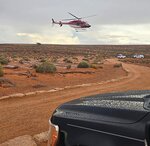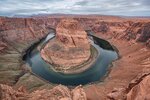On Aug. 12, shortly before 4 p.m., two women were struck by lightning at Horseshoe Bend in Glen Canyon National Recreation Area. National Park Service Public Information Officer Mary Plumb said, …
This item is available in full to subscribers.
To continue reading, you will need to either log in to your subscriber account, below, or purchase a new subscription.
Please log in to continue |



On Aug. 12, shortly before 4 p.m., two women were struck by lightning at Horseshoe Bend in Glen Canyon National Recreation Area. National Park Service Public Information Officer Mary Plumb said, “Classic Air Medical and City of Page Fire Department quickly responded to assist National Park Service Rangers with on scene patient care.” The victims were flown to St. George Regional Hospital in Utah by Classic Air Medical helicopters.
The victims, ages 22 and 23, were visiting from the Netherlands and Australia. Though not confirmed, sources report they are both in stable condition.
Arizona’s monsoon season is dangerous for outdoor activities. It’s important to monitor weather forecasts. If thunderstorms are predicted, postpone plans or make sure there’s a safe shelter close by.
According to the Centers for Disease Control and Prevention (CDC), “About 40 million lightning strikes hit the ground in the United States each year. But the odds of being struck by lightning in a given year are less than one in a million, and almost 90 percent of all lightning strike victims survive. The odds of being struck multiple times is even less, with the record being seven times in one lifetime. There are some factors that can put you at greater risk for being struck, such as participating in outdoor recreational activities or working outside. Regional and seasonal differences can also affect your risk of being struck by lightning.
“Watch for the development of large, well-defined rising cumulus clouds. Cumulus clouds have flat bases and dome or cauliflower shapes. Cumulus clouds can develop into thunderstorms. Once the clouds reach 30,000 feet, the thunderstorm is generally developing, and it is time to head for shore. As clouds become darker and more anvil-shaped, the storm is already in progress.”
Avoid open spaces and open structures. The CDC says, “Tents, picnic shelters, gazebos, baseball dugouts, and other open shelters DO NOT provide protection from lightning. Safe shelters include homes, offices, shopping centers, and hard-top vehicles with the windows rolled up.”
If there’s no safe shelter nearby, crouch low with only feet making contact with ground.
Worldwide, there are about 6,000 lightning strikes per minute, over eight million a day.
Most lightning deaths happen in the summer, often on the weekends between noon and 6 p.m. In Arizona, there are 16 to 30 lightning deaths each year. Florida and Texas have over 30 lightning deaths each year.
The CDC says, “From 2006 through 2021, leisure activities such as fishing, boating, playing sports, and relaxing at the beach accounted for almost two-thirds of lightning deaths.
“Work-related activities contribute to about 18 percent of total lightning fatalities, with farmers and ranchers at highest risk. Most work-related lightning strikes are among males.”